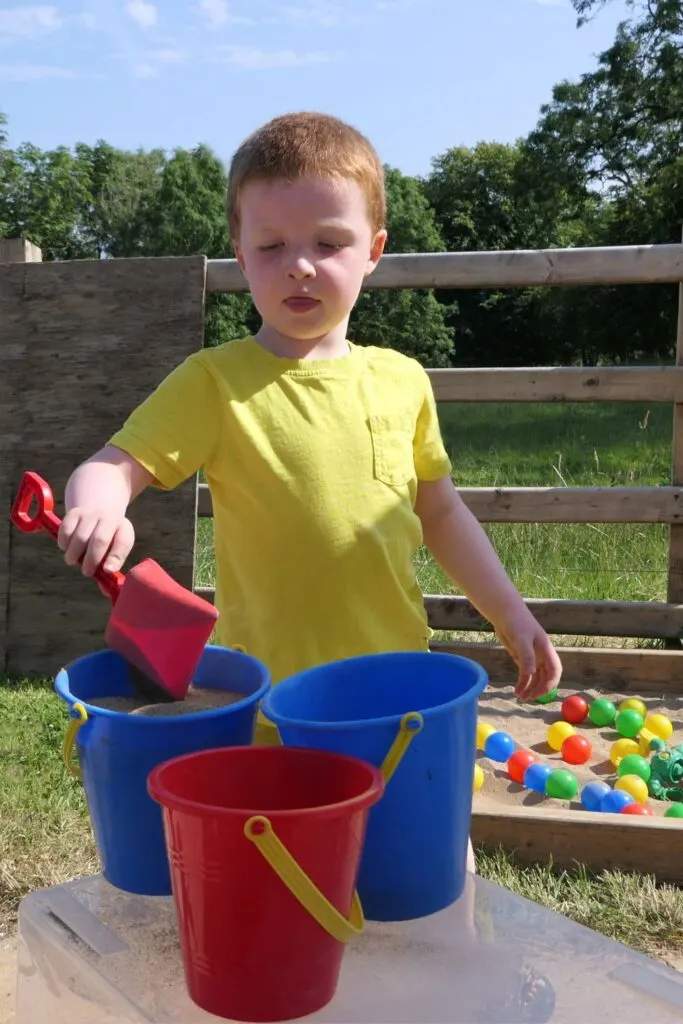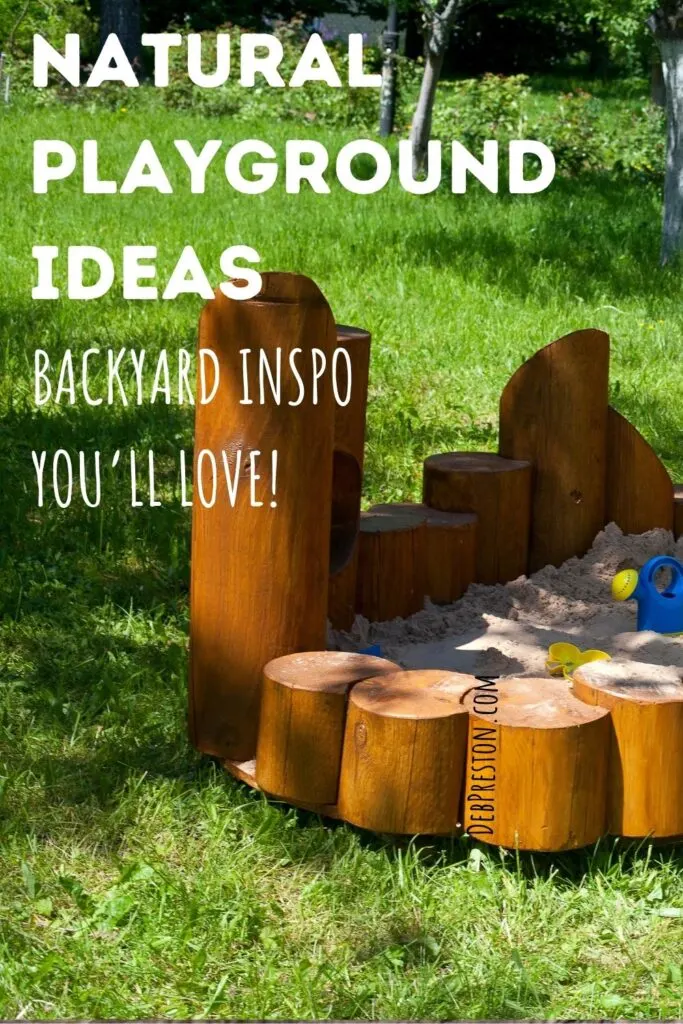When I was choosing a preschool for my daughter, I fell in love with one in particular. I loved that the majority of their time was spent outside, that learning was exploratory, and that gardens and animals would be a part of her experience there.
But…where were the jungle gyms?!
While the other preschools I toured boasted shiny new playgrounds with traditional playgrounds, swing sets, and a climbing wall or two, this school opted out of traditional play structures in favor of a sand box, water table, mud kitchen, old tires, rotating sensory bin, and pipes fastened onto a chain link fence, all surrounded by mature trees and repurposed materials. I mean…didn’t kids need traditional playgrounds to have fun?!
But it turns out that not only did our daughter have more fun in these natural play areas, she wanted to bring those natural elements home to our backyard! And while the idea can sound overwhelming, it turns out there are lots of ways you can bring natural playground ideas to life in your own backyard!
Understanding Natural Playgrounds
Natural play areas bring the outdoors into play.
They use earth, wood, water, and stones to create fun spaces for kids. These areas can not spark imaginative play but also connect children with nature.
Benefits of Natural Elements in Play
Natural play areas offer a whole host of perks for kids.
They help develop balance and coordination.
You’ll see your children climb logs, jump on rocks, and explore uneven surfaces. This builds strength and confidence.
Natural playgrounds also boost creativity!
Kids make up games with sticks, leaves, and pebbles. Empowered by free play, they build forts and create imaginary worlds.
Plus, a natural playscape changes with the seasons, keeping play fresh and exciting.
Playing in nature has been shown calm kids too. The sights, sounds, and smells of the outdoors soothe the senses and can improve mood and focus.
Natural vs. Traditional Playgrounds
How do you know if you should incorporate natural playground ideas in your backyard or take a more traditional route? It’s going to depend on your personal preferences!
Traditional playgrounds (like the jungle gyms you find at most schools and parks) are usually constructed of metal and plastic equipment.
They’ll stand out as obvious play structures intended for children and will require little to no maintenance thanks to their composition. That’s a win-win in many people’s books!
In contrast, natural playgrounds use materials from nature instead. You’ll find logs, boulders, and a sand box rather than slides and swing sets.
Natural play areas tend to blend into the landscape, appearing to be a more natural part of your yard. This creates a more peaceful, less cluttered space.
Kids can run, hide, and explore freely within natural features. The natural elements involved will also mean they’ll be more likely to extend their free play beyond the “designated” natural backyard playground.
It’s also important to remember that while traditional playgrounds will remain relatively unchanged over the years, natural play spaces will change over time.
Plants grow, logs weather, and the area evolves. This keeps play interesting and teaches kids about nature’s cycles, but will also require occasional upkeep.
Incorporating the Natural Environment
Creating a natural playscape can be as simple or as complicated as you’d like to make it!
Start by looking at what’s already in your yard.
Big trees make great climbing spots. A slope can become a slide or roll-down hill. Large rocks can be perfect for jumping.
Large flat rocks become stages for performances. Tree stumps transform into tables for mud pies or seats for storytelling. Hollow logs can become tunnels or drums.
Have some open space? It may be the perfect location for a sand box or mud kitchen!
Is there an area that tends to flood or pool? Consider creating a backyard stream to both aid in drainage and allow for shallow water play!

Designing Your Natural Playscape
Creating a natural playscape in your backyard lets kids connect with nature while having fun. You can use natural materials and features to make a unique play area that sparks imagination and adventure.
Choosing the Right Natural Materials
When building a natural playground, pick materials that blend with the environment.
Use fallen tree branches, logs, and stumps for climbing and balancing. Rocks and boulders make great focal points and climbing challenges. Sand and pebbles work well for sensory play areas.
Avoid treated wood, which can contain harmful chemicals. Instead, opt for cedar, redwood, or robinia wood for their natural durability.
For natural pathways, consider using wood chips, gravel, or stepping stones.
And don’t forget about plants! Tall grasses, shrubs, and trees add texture and create fun hiding spots.
Choose native species when possible to support local ecosystems and ensure the health and longevity of these natural features.
Working with Landscape Architects
Not sure where to start or what’s possible in your particular space? Landscape architects can help bring your natural playscape vision to life!
They’ll assess your yard’s layout, drainage, and sunlight to create an optimal design. These pros know how to seamlessly blend natural play spaces with your existing landscaping.
While employing their help can drive up the price tag on your backyard makeover, the expertise landscape architects bring to the table will also maximize your space and budget.
When meeting with a landscape architect, be sure to share your ideas and priorities. Bring photos of natural playscapes you like but be open to their suggestions – they might have creative solutions you hadn’t considered.
Natural Features to Include
Water features add fun and sensory experiences to your playscape!
Consider a shallow stream, small pond, or water pump. You’ll want to make sure any water is no more than a few inches deep for safety purposes.
Hills and mounds encourage running, rolling, and sliding.
You can create these with extra soil from other landscaping projects. Add a tunnel through a hill for extra excitement!
Incorporate loose parts like sticks, pinecones, and leaves for open-ended free play.
A mud kitchen lets kids get messy and creative while keeping the mess outdoors.
Set up bird feeders or plant butterfly-friendly flowers to attract wildlife. This will not only make your natural play areas feel more inviting, but also create opportunities for your child to learn more about natural science.
Creating Play Areas for Different Age Groups
While it’s tempting to think that natural playgrounds are only intended for younger children, they can be designed to suit kids of all ages. By including varied elements, you can create spaces that are both safe for young children and exciting for older children.
Safe Zones for Younger Children
For toddlers and younger children, focus on low-height structures and soft surfaces. Use play cushion mulch to create safe landing areas.
Add small tree stumps for stepping and balancing. Low balance beams made from logs can help develop coordination.
Set up a sensory garden with different textures and smells. This engages young children’s senses as they explore.
A small sand pit or water table lets kids splash and play safely.
Consider a mini obstacle course with tunnels made from willow branches. This encourages crawling and basic climbing skills.
Keep everything close to the ground and within easy reach.

Challenging Spaces for Older Children
Older kids need more exciting options to stay engaged. (Or so my big kid tells me!)
Build taller climbing structures using ropes and wooden beams. Create a more complex obstacle course with higher balance beams and swinging bars.
Add a treehouse or elevated platform for imaginative play. Ensure it has safe railings and a sturdy ladder.
Hang a tire swing, rope swing, or (my daughter’s favorite) hammock chair from a strong tree branch. Use large boulders or tree stumps to create footrests or small tables beside it.
Include areas for building and creating. While they might consider themselves too old for a mud kitchen, it’s amazing what my daughter can think up and create with a hammer, nails, and loose wood at the same table.
And while loose parts like pinecones and rocks don’t draw her in like they used to, branches, poles, sheets, and ropes have entertained her and her friends for hours as they’ve constructed forts and obstacle courses and “inventions.”
Consider setting up a nature observation area with binoculars, magnifying glasses, bug catcher, and guidebooks. This encourages learning about local plants and wildlife.
Integrating Educational and Sensory Elements
Natural playgrounds offer great ways to mix learning and play. These fun natural elements teach kids about nature while engaging their senses.
Incorporating a Sensory Garden
A sensory garden is a great addition to your backyard playground. It allows kids to explore different textures, smells, and colors.
You can plant herbs like mint and lavender for scent. Add soft lamb’s ear plants for touch. Include colorful flowers like marigolds and sunflowers.
Create paths with different materials.
Use wood chips, pebbles, and sand. This gives kids varied textures to walk on.
Add wind chimes or a small fountain for sound. These elements help develop sensory awareness, while also teaching about plants and nature.
Building a Mud Kitchen
A mud kitchen encourages imaginative play and boosts creativity.
Set up a small table with old pots, pans, and utensils. Kids can “cook” with mud, leaves, and sticks.
This area helps develop fine motor skills.
Mixing, pouring, and scooping build hand strength. It’s also great for social skills as kids play together.
Add a small chalkboard for writing recipes. This mixes in some literacy practice!
You can also include measuring cups to help teach basic math concepts.
Setting Up a Water Table
A water table is a fun, wet play area. Fill it with water and add cups, funnels, and boats.
Kids can learn about water flow and floating objects, add food coloring to experience color mixing, or toss in a few ice cubes to witness the magic of melting. These simple activities teach basic science concepts.
You can add small pebbles or bath toys for extra fun. Frankly, when my daughter was smaller, we found that almost any plastic toy could enhance our water table fun, then be dried off to return safely to the house!
Just be sure to change the water often and keep it shallow for safety purposes.

So…which natural playground ideas will you use in your backyard? I can’t wait to hear all about it!
Enjoy your new outdoor space, friend!

P.S. Ready to revamp more than just your backyard? The Take Charge Collection of 15 free resources will help you to simplify, organize, and take charge of your life! Get yours free HERE!
Disclosure: While all opinions are our own, we are a participant in the Amazon Services LLC Associates Program and other affiliate advertising programs, designed to provide a means for us to earn fees by linking to Amazon.com and affiliated sites, at no additional cost to you.



